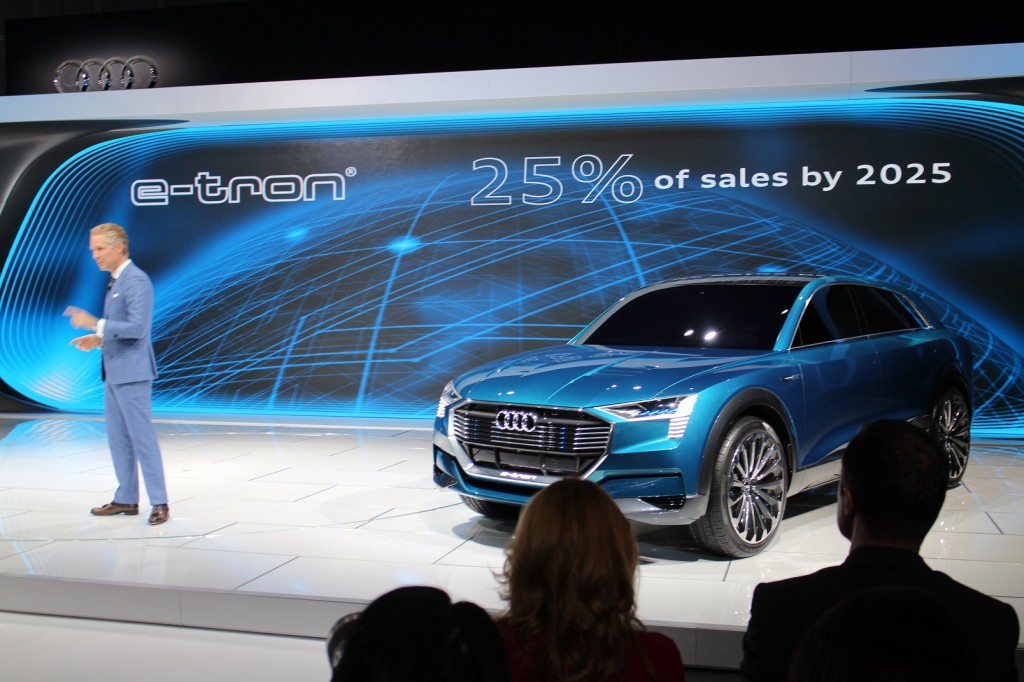While there have been lots of concept cars and production announcements, the first serious German competitor to the Tesla Model S and Model X won't arrive for at least another year.
And what could prove the most potent of them all—the production version of the stunning Porsche Mission E concept car revealed two years ago—won't go into production for another two years.
Still, we've learned a bit more about that car, which will go on sale at the end of 2019 as a 2020 model, from comments by Porsche chairman Oliver Blume.
DON'T MISS: 2018 Porsche Mission E: 600-HP Electric Sport Sedan Concept Targets Tesla
Porsche didn't reveal any new electric vehicles at last week's Frankfurt auto show, which saw a host of battery-electric concept cars from Audi and Mercedes-Benz.
But Blume spoke to Britain's Car magazine about the brand's upcoming electric sport sedan, as well as the company's fast-charging plans.
From a few of his comments, a case could be made that if any maker can offer a "Tesla-beater" electric car, the Mission E could be it.

Porsche Mission E concept electric car
One important point that emerged from Car's interview with Blume concerned the Mission E's price: it will be comparable to that of today's Porsche Panamera sedan.
That actually covers a wide range, from a base model at $85,000 to limited-edition high-performance versions that can approach twice that amount when fully loaded.
But Blume told the magazine the Panamera would be priced like "an entry-level Panamera," with an array of performance options—presumably meaning motor outputs and battery capacities.
When the car debuted at the 2015 Frankfurt show, Porsche quoted 0-to-62-mph acceleration times of 3.5 seconds, and just 12 seconds to 125 mph (200 km/h).
Total battery range is quoted at 300 miles (500 km), though that's likely on the gentle European test cycle; a more realistic U.S. EPA figure might be 250 miles.
Its versions will "likely" follow the current Porsche hierarchy of models, Blume said, meaning S, GTS, and so forth.

2017 Tesla Model S
In other words, it sounds as though Porsche might have the Tesla Model S squarely in its sights.
That car has lately had a profusion of changes, almost monthly, to its versions, specifications, features, and prices, so we're not going to quote a price for this month's base model.
Another point, perhaps the most interesting, was Blume's assertion that every version of the production Mission E would come equipped with 350-kilowatt DC fast-charging ability from the start.
CHECK OUT: Porsche prototype 350-kw electric car fast-charging station installed
That charging rate will provide an 80-percent recharge, or perhaps 200 to 250 miles, in just 15 minutes at suitably equipped DC fast-charging stations.
Tesla Supercharger stations today can charge at up to 135 kw, giving an 80-percent recharge for most models in roughly 30 minutes, in some cases depending on load and the number of cars charging simultaneously.
The ability of a Porsche Mission E driver to gain 200 miles of range in just 15 minutes on road trips will depend on whether fast-charging stations with that capability come online between now and early 2020.

Audi of America president Scot Keogh with Audi e-tron quattro concept, 2015 Los Angeles auto show
For the U.S. at least, Porsche is clearly expecting those to come from the Electrify America project, VW Group's $2 billion effort to install infrastructure for zero-emission vehicles both in California and across the rest of the country.
The first 30-month portion of that plan was approved both by California and federally this spring, and the stations planned in that phase should largely have been built out by the time the Mission E arrives at Porsche dealers.
Meanwhile, another VW Group company faces a similar need: The Audi e-tron all-electric crossover utility vehicle will have 150-kw fast charging, the company said two years ago.
Where that will come from when the car launches roughly a year from now remains to be determined.
_______________________________________













